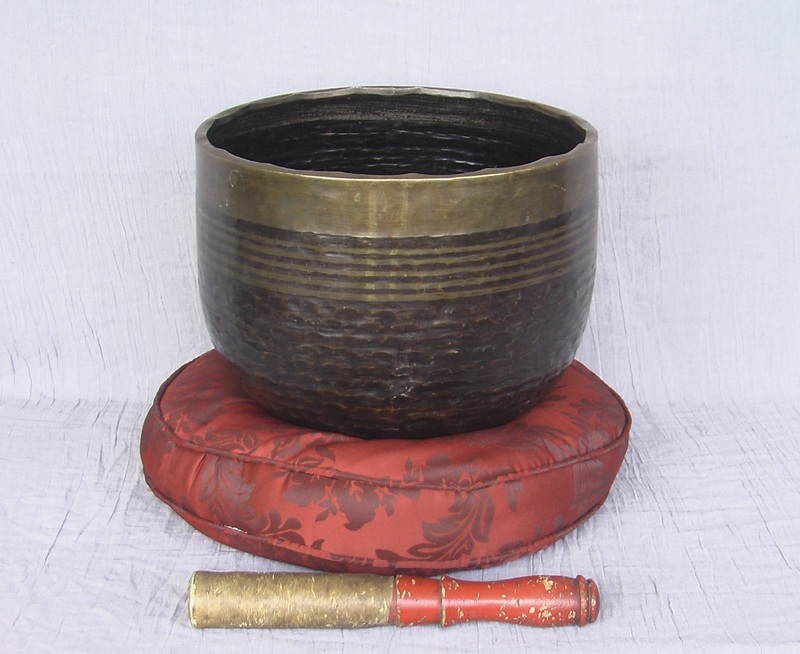dobachi
Also: kin rin uchinarashi keisu kinsu shari daikin daikeisu namarin
Contextual Associations
The dobachi is a bronze resting bell associated with Japanese Buddhist practices. It is found both in Buddhist temples and as part of shrines in the homes of Buddhist practitioners. It might best be thought of as a sonic ritual instrument rather than as a musical instrument. Although in general it is used to mark the beginnings and ends of segments of a temple service (chanting, meditation, etc.), its precise use varies from one setting to another. Perhaps in part for this reason it is known by several different names; this page could have been headed by a number of different Japanese names, in particular: kin; rin, or uchinarashi, for example. But there are a few major museum collections (Metropolitan Museum of Art, Hartenberger, MIMO) possessing such resting bells labeled as dobachi, and so we have chosen to follow suit by favoring this name for such bells. In addition to its traditional use as a sound-producing ritual instrument for Buddhist services, the dobachi has been appropriated by some contemporary composers for their musical compositions.
Description
It appears that this dobachi was created from a disc of bronze (a copper and zinc alloy) through a process of hammering it into its hemispheric shape. It almost certainly involved repeated heating of the bronze to allow the craftsman to gradually produce its final bowl-like shape (detail #1). Numerous hammer-blow marks are visible on both the interior (detail #2) and exterior surfaces (detail #3) of the bell. The rim is carefully finished in the forging process with an undulating curve (detail #4). The bell rests on a pillow which, because it comes in contact only with the bell’s acoustically dead apex, does not mute the sound of the instrument (which is produced by the vibration of its rim). A lacquer-painted wooden beater partially wrapped in leather (detail #5) is used to strike the bell on its rim to produce a sustained, steady pitch which is left to fade away naturally.
Player - Instrument Interface and Sound Production
The individual sounding this instrument as part of Buddhist worship is either a monk attached to the temple in which it is housed or a lay person living in the household in which the dobachi is a part of the family shrine. No technical training is necessary for the playing of this instrument, but the “performer” must be aware of the structure of the service and when it is appropriate to sound the dobachi. The leather-wrapped stick beater is held in one hand and is struck with an upward motion directed at the outside of the bell just below the rim. This dobachi produces a fundamental tone of D3, although it is difficult to isolate this pitch with certainty in part because of the several louder overtones that are given off by the ringing bell.
Origins/History/Evolution
According to Malm (pp. 64-65), Buddhism (which originated in India) arrived in Japan via China during the Nara Period of Japanese history (c. 600 – 800 CE). It is not known with certainty if the dobachi came to Japan from China as well, but Blades reports that the oldest dated Japanese dobachi (according to him located in the Mission Inn Museum in Riverside, California) was made in the Japanese year 2, or 646 CE. (Blades, p.132) If this is accurate information, the manufacture of bronze dobachi in Japan appears to date back nearly 1500 years.
Bibliographic Citations
Blades, James. 1970. Percussion Instruments and their History. New York: Frederick A. Praeger, Publishers.
De Ferranti, Hugh. 2000. Japanese Musical Instruments. New York: Oxford University Press Inc.
Haags Gemeentemuseum. 1979. Traditional musical instruments of Japan. Buren: Frits Knuf, Publishers ltd.
Malm, William P. 1959. Japanese Music and Musical Instruments. Rutland, Vermont: Charles E. Tuttle Company.
n.a. 2014. “Resting bell.” GDMI v.4:301.
Piggott, Sir Francis.1909. The Music and Musical Instruments of Japan. Yokohama: Kelly & Walsh, Limited. Reprint: 1971. New York: Da Capo Press.
Instrument Information
Origins
Continent: Asia
Region: East Asia
Nation: Japan
Formation: Japanese
Classification (Sachs-Von Hornbostel revised by MIMO)
111.242.11 idiophone—individual resting bell placed on the palm of the hand or on a cushion, its mouth faces upwards
Design and Playing Features
Category: idiophone
Energy input motion by performer: hammering
Basic form of sonorous object/s for idiophone: hollow hemisphere - open
Sound objects per instrument: one
Resonator design: sonorous object itself is a general resonating space
Number of players: one
Sounding principle: striking - direct
Sound exciting agent: beater/s - partially padded stick/s
Energy input motion by performer: hammering
Pitch of sound produced: definite pitch
Sound modification: none
Dimensions
14.2 in. greatest diameter (and at rim)
11.3 in. height
0.5 in. thickness of wall
13.2 in. length of beater
1.6 in. diameter of beater
Primary Materials
bronze
wood
leather
Entry Author
Roger Vetter






